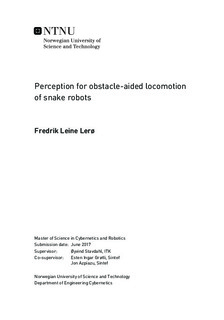Perception for obstacle-aided locomotion of snake robots
Master thesis
Permanent lenke
http://hdl.handle.net/11250/2458491Utgivelsesdato
2017Metadata
Vis full innførselSamlinger
Sammendrag
The goal of this project was to provide an obstacle-aided snake robot with improved perceptual capability. This implies ensuring that objects located in the snakes' close proximity get a high resolution digital representation. Kintinuous, an algorithm used for mapping an unknown environment while at the same time keeping track of an agents location within it, is the perceptual system of the snake robot. The algorithm maps the environment by getting RGB-images and depth data from a depth sensor called Kinect. The Kinect has a limited range for where it can obtain depth data. Objects located outside this limited range will get a low resolution digital representation, or no representation at all. To compensate for this limited range, Kintinuous was altered by adding a new system component responsible for computing depth maps with high resolution at lower ranges. The depth maps were computed by using stereo vision principles. The Kinect has a single RGB-camera that is used to capture two different views of the scene, at different times. The new system component then proceeds to compute the matrix relating the two different views in pixel coordinates, by exploiting the Kintinuous tracking information. The images are then rectified to make them row aligned, a dense disparity map computed by matching corresponding pixels, and a depth map acquired. The results of each part of the system showed the rectification to be inaccurate, resulting bad performance of the matching algorithm. This lead to depth maps being very noisy or completely useless. The depth map fusing was with Kintinuous was though never achieved. Further work is necessary to make this work as intended, and this thesis is believed to form a good basis for the development of a capable algorithm.
